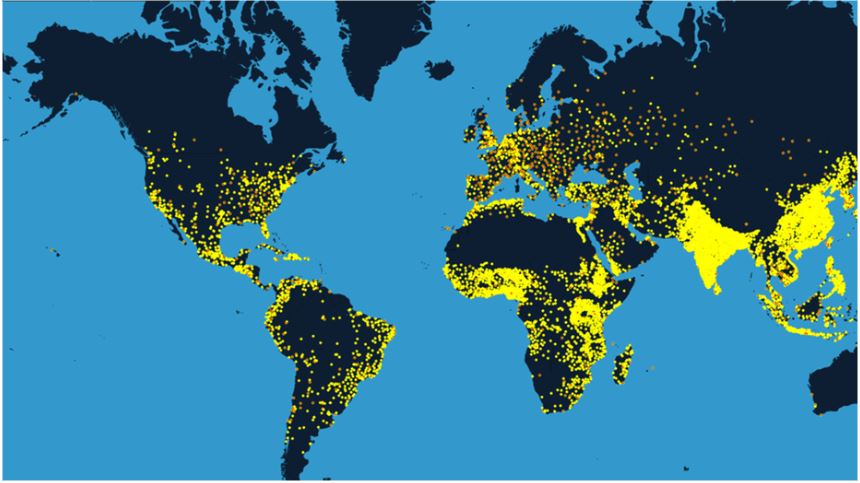Cities have become the physical structure of opportunities and challenges alike, from where we must act and react. We are presented with an opportunity to re-engage the way that cities are planned, designed, financed, developed, and governed.
In this context, we have to understand smart cities as an
opportunity if we recognize it as a strategy whose final objective is not the use of applied technology, but, above all, to improve the quality of life of its inhabitants by making use of all possible tools.
Urban development is a process of an extremely high level of significant in society, a process that can improve the quality of life of an entire population. It is about the
transformation and structural change of human places, mainly cities since they have become the main containers of the population in the world.
Cities as urban stage
Map showing how the main concentrations of population will be distributed in
2050. 
Source: WorldPopulationHistory.org
The city is presented as a urban stage in the future framework of world life, scenario in which through urban development the balance between the physical, economic, and social aspects is pursued, it means the possibility of an adequate physical space where the basic social needs of health, culture, housing, food, work, and education are met. Beside the physical and
demographic expansion, it also implies the increase of the productive activities, the elevation of the socioeconomic conditions of the population, the conservation and improvement of the environment and the maintenance of the cities in good working conditions. Therefore, cities have become the structure of both opportunities and challenges alike.
Urban development challenges
The
smart city strategy is considered an ideal tool that we can use to act and react to these challenges, readdressing the way cities and human settlements are planned, designed, financed, developed, and governed; taking advantage of information and communications technology to improve livability, workability and sustainability. Once the decision to opt for the smart city’s strategy has been defined, we must consider a series of challenges that arise to design, implement, and evaluate an adequate urban development. Improvement of the transversal analysis of the territory and its diagnosis. It is urgent to widespread the use of geographic information systems that analyze the territory in an integral way. A dynamic analysis over time that incorporates statistical analysis to detect trends and to "forecast" future behaviors. -
Improving the metrics of urban development There is a strong need to monitor progress, applying systematic risk assessment schemes to urban development policies and projects. Track the causality path throughout devising counterfactuals that can allow to visualize the impact of smart territorial projects.
- Lack of urban categorization, multiscale analysis A thorough analysis of local challenges, the determinants of poverty and inequality and the drivers of sustainable development would largely contribute to clarify the role of cities in addressing global challenges, according to their context and needs. -
The term ‘smart’ is intrinsically linked to technology That inextricably leads to a reductionist view of urban development. The application of technology is like the hammer metaphor: it depends on the purpose of its use. For ensuring the pro-equity application of technology to sustainable urban development, a more holistic and profound debate on the role of technology in life is much needed. The ‘
Smart Cities’ buzz is giving way to ‘City Sciences’. This is a necessary move for integrating a holistic, crosscutting, and structured approach to understand cities as complex ‘live’ organisms. The society in general has a big responsibility in addressing future needs, advancing towards greater social cohesion, breaking down social divides, promoting participatory and inclusive local governance, and fostering sustainable development.
Author:
Daniela Idrovo Alvarado. Expert in Urban Planning, Design and Management, Urban Safety and Crime Prevention. Communication and fundraising coordinator at La Dinamo Fundació. Professor in the Master's in Global Smart City Management of Zigurat.



